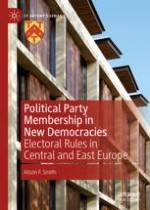2020 | OriginalPaper | Chapter
2. Electoral Institutions and Party Membership
Author : Alison F. Smith
Published in: Political Party Membership in New Democracies
Publisher: Springer International Publishing
Activate our intelligent search to find suitable subject content or patents.
Select sections of text to find matching patents with Artificial Intelligence. powered by
Select sections of text to find additional relevant content using AI-assisted search. powered by
